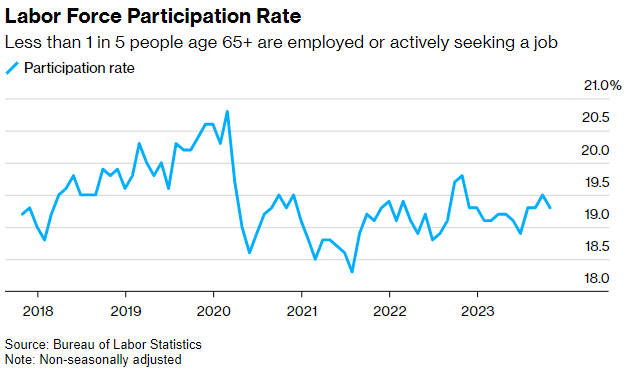|
More than three-and-a-half years after COVID struck, the U.S. still has around 2 million more retirees than predicted, in one of the most striking and enduring changes to the nation’s labor force. The so-called, 'Great Retirement,' induced by COVID-19 is evident in the divergence between the actual number of retirees and that predicted by a Federal Reserve economic model. While down from a 2.8 million gap late last year, it remains elevated today and has even risen from 1.7 million in June. Before the pandemic, the participation rate for workers age 65 and older reached 20.8% before dropping two-and-a-half percentage points by July 2021. The rate has since risen a percentage point to 19.3% but remains well below the pre-pandemic high. The lack of older workers is creating some shortages. In Michigan, a state law was tweaked to make it easier for teachers to “un-retire” without risking their pensions.
Before this summer’s rise in excess retirees, there was speculation that a whole “un-retirement” wave was under way, but that seems to have not been the reality. For many older Americans, leaving the labor market is a one-way street. While many may miss the routine and stimulation and want to resume work for financial reasons, rejoining the workforce can be difficult. Skills decline, work connections rapidly fade and job-seekers may confront an age gap, all making it harder for many older workers to find a job. In 2022, the mean duration to find a job for people age 65 and older was 31.6 weeks, 9 weeks longer that the overall average. Before the pandemic, from 2017 to 2019, roughly 3% of retired workers on average ended up having a job a year later. Source: https://www.bloomberg.com/news/articles/2023-11-06/us-retiree-surplus-is-still-near-two-million-years-after-covid?utm_source=website&utm_medium=share&utm_campaign=email&leadSource=uverify%20wall#xj4y7vzkg
0 Comments
Leave a Reply. |
Archives
July 2024
Categories
All
|
Let our team work for you. Call 979-694-9100 or
email [email protected]
|
TRADITIONS WEALTH ADVISORS
2700 Earl Rudder Frwy South, Ste. 2600 College Station, TX 77845 |
VISIT OUR BLOG: Stay current with industry news and tips.
|



